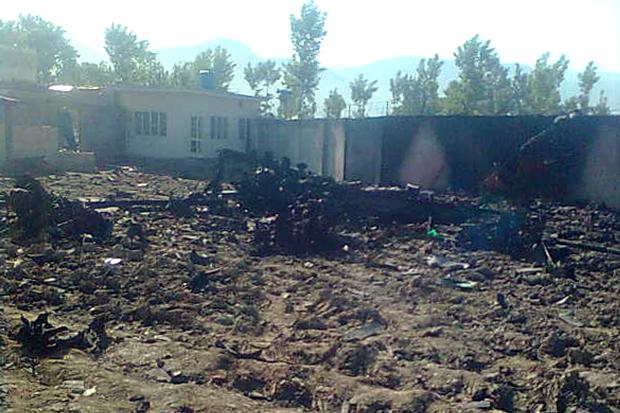| | International 
[ 2011-05-05 ] 

The helicopter that crashed inside bin Laden's compound was partially destroyed by Seals as they left EPA
Fallen US helicopter may have been unknown stealth version
The helicopter that crashed inside bin Laden's
compound was partially destroyed by Seals as they
left EPA
The intention was to destroy it entirely but some
debris survived the explosions EPA
Defence experts believe it may have been a Stealth
helicopter, not seen in combat before EPA
US and UK experts have noticed alterations to a
normal helicopter that may have helped it reduce
its noise levels EPA
This may have been the first time such a
helicopter was tested in live combat EPA
Tom Coghlan Defence Correspondent
Last updated May 5 2011 4:52PM
The partially burnt remains of a helicopter which
crashed during the mission to kill Osama bin Laden
is believed by experts to be a previously unknown
highly classified Stealth version.
The aircraft was blown up with multiple explosive
charges at the scene by US Special Forces soldiers
in an apparent effort to destroy evidence.
However, the surviving tail section shows what
analysts believe to be an aircraft designed to
help evade radar and dramatically reduce aircraft
noise – which would have allowed US forces to
avoid detection up until moments before they
landed at bin Laden’s compound.
Bill Sweetman, an analyst with the respected US
magazine Aviation Week speculates that the
helicopter was a highly modified H-60 Black Hawk
helicopter.
“The helicopter’s tail features
stealth-configured shapes on the boom and the tail
rotor hub fairings, swept stabilisers and a
‘dishpan’ cover over a five-or-six-blade tail
rotor,” he wrote yesterday.
The increased number of rotor blades would help
with reducing noise and were likely matched with
more blades on the main rotor assembly for the
same reason. The disk added to the tail rotors
appears also to be a noise reduction device to
increase the element of surprise by disguising the
distinctive clatter of an approaching helicopter.
“This is not a radical, super helicopter but a
very clever bit of engineering on an existing
configuration,” Paul Beavor, a former editor of
Janes and Helicopter Week told The Times.
“It is mainly noise they are interested in and a
little bit of stealth, but mainly noise
reduction,” he added. “It is very difficult to
mask the noise of a helicopter completely, but
with good engineering and science you can reduce
the noise footprint. The whole intention is to
arrive very fast and quiet to take people by
surprise.”
The surviving tail also seems to indicate that the
wheels of the helicopter were retractable in
flight, further reducing its visibility to radar
and increasing its speed.
Stealth technology generally works less well on a
helicopter because disguising the aircraft’s
radar signature is complicated by the high number
of moving parts.
However, the American Army Times quotes an
unidentified “retired special operations
aviator” describing a longstanding programme to
develop stealth helicopters dating back to the
1980s.
The aviator claims that US Special Operations
Command ordered a number of “low-observable”
Black Hawk helicopters in about 2000.
Experts said that helicopters operating at low
level would be harder to spot on radar because of
“ground clutter”.
“Pakistan may well not have known they were
there. It would be a combination of technology,
terrain and tactics,” said Mr Beaver.
The Pakistani military only scrambled fighter
jets, it was reported, as the American force was
leaving their airspace.
The US Government would certainly not wish such
technology to fall into the hands of China, an
ally of Pakistan’s, which has its own stealth
technology programme.
The J20 aircraft, China’s first stealth
aircraft, made its maiden flight in January. The
aircraft is suspected to include technology copied
by China after the downing of a US stealth
aircraft in Kosovo in the 1990s saw pieces of the
plane bought up by Chinese embassy officials from
local farmers.
It remains unclear what caused the crash of the US
helicopter in Abbottabad. Analysts have speculated
that it was operating at the limits of temperature
[which affects lift] and altitude – at around
4,000 feet with a heavy load of men on board.
Asked by reporters about why the helicopter
crashed, US Senate Intelligence Committee
chairwoman Dianne Feinstein said: “The
temperature was 17 degrees higher than
anticipated, and based on the temperature, and the
load in the helicopter, the helicopter began to
descend, and so it was a kind of controlled but
hard landing.” Source - The Times(UK)

... go Back | |




